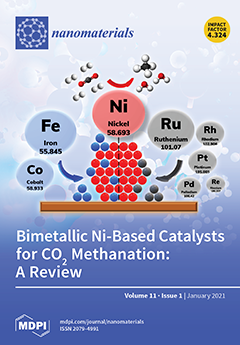A detailed investigation is presented for the solvent-free mechanochemical synthesis of zinc oxide nanoparticles from ε-Zn(OH)
2 crystals by high-energy ball milling. Only a few works have ever explored the dry synthetic route from ε-Zn(OH)
2 to ZnO. The milling process of ε-Zn(OH)
[...] Read more.
A detailed investigation is presented for the solvent-free mechanochemical synthesis of zinc oxide nanoparticles from ε-Zn(OH)
2 crystals by high-energy ball milling. Only a few works have ever explored the dry synthetic route from ε-Zn(OH)
2 to ZnO. The milling process of ε-Zn(OH)
2 was done in ambient conditions with a 1:100 powder/ball mass ratio, and it produced uniform ZnO nanoparticles with sizes of 10–30 nm, based on the milling duration. The process was carefully monitored and the effect of the milling duration on the powder composition, nanoparticle size and strain, optical properties, aggregate size, and material activity was examined using XRD, TEM, DLS, UV-Vis, and FTIR. The mechanism for the transformation of ε-Zn(OH)
2 to ZnO was studied by TGA and XPS analysis. The study gave proof for a reaction mechanism starting with a phase transition of crystalline ε-Zn(OH)
2 to amorphous Zn(OH)
2, followed by decomposition to ZnO and water. To the best of our knowledge, this mechanochemical approach for synthesizing ZnO from ε-Zn(OH)
2 is completely novel. ε-Zn(OH)
2 crystals are very easy to obtain, and the milling process is done in ambient conditions; therefore, this work provides a simple, cheap, and solvent-free way to produce ZnO nanoparticles in dry conditions. We believe that this study could help to shed some light on the solvent-free transition from ε-Zn(OH)
2 to ZnO and that it could offer a new synthetic route for synthesizing ZnO nanoparticles.
Full article






